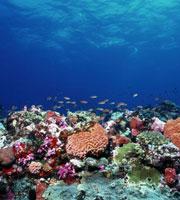
Carbon dioxide (CO2) isn't the only atmospheric pollutant making the oceans more acidic and threatening the health of coral reefs and plankton. New research suggests that nitrogen and sulphur released into the air by human activities may be driving down the pH more than expected in some coastal waters.
Increasing CO2 levels are expected to change the acidity of the Earth's waters from 8.2 to about 7.8 by the end of this century. But less attention has been paid to the effects on the acidity of ocean waters of the nitrogen and sulphur compounds emitted by fertilizers and fossil fuels.
The reasons for this neglect are simple. Although atmospheric nitrogen and sulphur compounds are well known for showering the Earth with acid rain, the vast volume and mighty buffering power of the sea was thought to makes oceans resilient to this effect.
Added to that is the simple issue of scale. Humans add 6 teramoles of reactive nitrogen and 2 teramoles of sulphur to the atmosphere every year, says geochemist Ken Caldeira of Stanford University in California. In contrast, yearly release of CO2 is 700 teramoles. "Based on this consideration alone, one might expect the acidification from CO2 emissions to be nearly 100 times greater than the acidification resulting from nitrogen and sulphur emissions," he says.
When Scott Doney of Woods Hole Oceanographic Institution in Massachusetts and his colleagues modelled the impacts of nitrogen and sulphur compounds on ocean acidity, their results supported the idea that, in general, nitrogen and sulphur contribute only a small percentage of the effect of CO2 to ocean acidification. But, they report in Proceedings of the National Academies of Sciences USA this week1, in some areas these gases have 10-50% of the impact of CO2.
Local impact
"On the global scale, if you add them all up, the impacts of nitrogen and sulphur are small," says Doney. "But when you start looking at spatial and regional impacts, they can be pretty important."
The hardest-hit areas would be those closest to the sites where air pollution is taking place, because reactive nitrogen and sulphur compounds tend to come raining back down to Earth within days to a week of being emitted, giving them little time to travel.
Oceanographers say it is clear that these elements can increase acidity. But the scale of the effect predicted by Doney is surprising.
"I would be surprised that coastal areas are so sensitive to this input," adds biological oceanographer Ulf Riebesell of the Leibniz Institute of Marine Sciences in Kiel, Germany. He says he would expect physical and biological effects to mediate the acid - adding nitrogen also stimulates plankton productivity, for example, which in turn lowers the concentration of dissolved inorganic carbon and makes water more alkaline. But Doney's model accounts for such effects and still comes up with a hefty impact on ocean acidity.
While nitrogen and sulphur may contribute more to acidification of coastal waters, they remain only a small part of the full picture, adds Caldeira. "There are plenty of good reasons to curtail emissions of both sulphur and reactive nitrogen," he says. "However, if we are concerned about diminishing the threat posed by ocean acidification, we must work much, much harder to decrease our CO2 emissions - these must be decreased dramatically and soon."

No comments:
Post a Comment